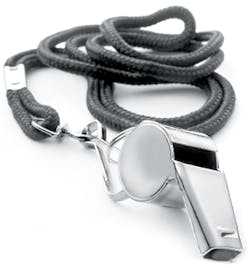You are the safety director of a medium-size company. The superintendent of the production department comes to you with a complaint about a problem employee, Clumsy Clarence. The superintendent wants to fire Clarence, but Clarence is keenly aware of OSHA.
You fear that before he is fired, Clarence will get wind of what is happening and, in an attempt to make himself "bullet proof," file a safety complaint with the safety enforcement branch of OSHA. Firing Clarence then would become much more difficult, as he could complain to the "whistleblower" branch of OSHA that he was discriminated against for being a whistleblower, in violation of section 11(c) of the OSH Act.
See Also: Occupational Health Safety Standards & Regulations
You fear that a misstep could cause your company to spend time and money convincing an OSHA discrimination investigator that Clarence was fired for being a bad employee, not for filing a safety complaint. Worse, if you lose a discrimination case, you might be required to pay back wages, reimburse expenses for attorney's and expert's fees, reinstate the employee and even pay punitive damages. You also may be the subject of a nasty press release, a legally questionable practice OSHA openly calls "regulation by shaming."
Examples of such press releases can be found on OSHA's Web site, http://www.OSHA.gov. Click on "Newsroom" to view the agency's press releases.
If an Employee Files a Complaint
If Clarence does file a safety complaint before you can fire him, an OSHA discrimination investigator may contact you to determine whether you discriminated against Clarence. The investigator will want to know how you dealt with Clarence, what your reasoning was for firing him and whether Clarence was singled out among your employees. How will you show the OSHA investigator that Clarence's termination was unrelated to his safety complaint?
You can recount the conversation you had with the superintendent when you decided to fire Clarence. You can get the superintendent to corroborate your story. You can even have a supervisor attest that Clarence did poor work, with a bad attitude, and violated loads of safety rules. But this evidence creates a he-said/she-said problem, which easily can start you down the path to protracted investigation and even a formal 11(c) discrimination complaint.
A better way to convince the OSHA investigator that you are not discriminating against whistleblowers is to maintain a comprehensive system of documentation. All disciplinary events should be documented in writing and filed in a retrievable manner. Even so-called oral reprimands should be memorialized (making them oral in name only). A documented trail of employee discipline will show the OSHA investigator that your reasons for firing Clarence were genuine and are not related to his safety complaint.
Consistency is Key
Implementing a documentation system is a crucial starting point, but if you hope to persuade the investigator, the system must be followed consistently. OSHA will exploit any inconsistency to impugn your motives. It would raise red flags if you document each time you reprimand Clarence, but not each time you reprimand other employees.
It also will hurt your case if you fail to follow other internal procedures, such as a careful review of the employee's record before he is fired. The problem is that a full review takes time. A drawn-out internal review can give an employee like Clarence the idea that he might be fired. It might occur to him that he can obstruct his firing by making a safety complaint to OSHA's safety enforcement branch. While you should not rush to judgment, there is a cost to prolonging the internal review. After your review of Clarence's record, document the decision and promptly terminate him.
All documentation, including the decision to fire an employee, not only should include dates but also times, so that the sequence of events is preserved. A few hours can make all the difference. Suppose you decide to fire Clarence, and the superintendent leaves your office. But 3 hours later, Clarence walks in and informs you that he made a safety complaint to OSHA. If you do not have a record of the time of your prior decision, it will be almost impossible to show the OSHA investigator that Clarence's termination was unrelated to his safety complaint. From the investigator's standpoint, it may look like the exact opposite. We once got OSHA to close a discrimination case because a time-stamped email showed that the decision to fire an employee was made several hours before he filed a safety complaint with OSHA's enforcement branch.
Comprehensive documentation of discipline also helps in fending off safety citations. Employers have a defense to OSHA citations if they can show that they enforce OSHA's safety standards through progressive discipline. The easiest way to make this point is through a system of documentation. For more information on how documentation of discipline can help avoid OSHA citations, please refer to our article "The Oft-Missed Step: Documentation of Safety Discipline" (EHS Today, January 2006).
With a consistent, comprehensive system of documentation, you will better be able to defend against safety citations and avoid discrimination claims. You more easily can terminate your problem employee without worrying about safety complaints. And if it comes to an OSHA investigation, you will better be able to convincingly demonstrate that you fired Clarence because he was clumsy.
Arthur G. Sapper is a partner in the OSHA Practice Group of McDermott Will & Emery, a former deputy general counsel of the Occupational Safety and Health Review Commission and a former professor of OSHA law. He has participated in numerous investigations and cases involving OSHA discrimination and safety complaints, and can be reached at 202-756-8246 or asapper@mwe.com. William M. Friedman is an associate at McDermott Will & Emery and can be reached at 202-756-8268 or [email protected].

